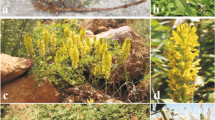Abstract
Resveratrol, a natural phytoalexin found mainly in grapes, possesses antibacterial, antifungal, and antiviral properties. However, there is no information about its effects on helminths such as Trichinella sp. In the present study, we investigated the effects of resveratrol on the viability of Trichinella spiralis life stages in vitro. Adult forms, newborn larvae (NBL), and muscle larvae (ML) were incubated with resveratrol at concentrations varying from 12.5 to 200 μg/ml. Resveratrol showed significant anthelmintic activity against NBL and adult forms of Trichinella, but not against ML. Our results suggest that resveratrol may be useful as a therapeutic agent to treat trichinellosis in early stages and warrant its further assessment in animal models of disease.
Similar content being viewed by others
References
Abu El Ezz NM (2005) Effect of Nigella sativa and Allium cepa oils on Trichinella spiralis in experimentally infected rats. J Egypt Soc Parasitol 35:511–523
Bass TM, Weinkove D, Houthoofd K, Gems D, Partridge L (2007) Effects of resveratrol on lifespan in Drosophila melanogaster and Caenorhabditis elegans. Mech Ageing Dev 128:546–552
Caner A, Döşkaya M, Değirmenci A, Can H, Baykan S, Uner A, Başdemir G, Zeybek U, Gürüz Y (2008) Comparison of the effects of Artemisia vulgaris and Artemisia absinthium growing in western Anatolia against trichinellosis (Trichinella spiralis) in rats. Exp Parasitol 119:173–179
Chabert P, Fougerousse A, Brouillard R (2006) Anti-mitotic properties of resveratrol analog (Z)-3,5,4'-trimethoxystilbene. Biofactors 27:37–46
Chan MM (2002) Antimicrobial effect of resveratrol on dermatophytes and bacterial pathogens of the skin. Biochem Pharmacol 63:99–104
Collins JJ, Evason K, Kornfeld K (2006) Pharmacology of delayed aging and extended lifespan of Caenorhabditis elegans. Exp Gerontol 41:1032–1039
Docherty JJ, Fu MM, Stiffler BS, Limperos RJ, Pokabla CM, DeLucia AL (1999) Resveratrol inhibition of herpes simplex virus replication. Antivir Res 43:145–155
Dupouy-Camet J (2000) Trichinellosis: a worldwide zoonosis. Vet Parasitol 93:191–200
Fremont L (2000) Biological effects of resveratrol. Life Sci 66:663–673
García D, Escalante M, Delgado R, Ubeira FM, Leiro J (2003) Anthelminthic and antiallergic activities of Mangifera indica L. stem bark components Vimang and mangiferin. Phytother Res 17:1203–1208
Juan ME, Vinardell MP, Planas JM (2002) The daily oral administration of high doses of trans-resveratrol to rats for 28 days is not harmful. J Nutr 132:257–260
Jung HJ, Hwang IA, Sung WS, Kang H, Kang BS, Seu YB, Lee DG (2005) Fungicidal effect of resveratrol on human infectious fungi. Arch Pharm Res 28:557–560
Kedzierski L, Curtis JM, Kaminska M, Jodynis-Liebert J, Murias M (2007) In vitro antileishmanial activity of resveratrol and its hydroxylated analogues against Leishmania major promastigotes and amastigotes. Parasitol Res 102:91–97
Kociecka W (2000) Trichinellosis: human disease, diagnosis and treatment. Vet Parasitol 93:365–383
Lai PK, Roy J (2004) Antimicrobial and chemopreventive properties of herbs and spices. Curr Med Chem 11:1451–1460
Lamas J, Morais P, Arranz JA, Sanmartín ML, Orallo F, Leiro J (2009) Resveratrol promotes an inhibitory effect on the turbot scuticociliate parasite Philasterides dicentrarchi by mechanisms related to cellular detoxification. Vet Parasitol 161:307–315
Leiro J, Cano E, Ubeira FM, Orallo F, Sanmartín ML (2004) In vitro effects of resveratrol on the viability and infectivity of the microsporidian Encephalitozoon cuniculi. Antimicrob Agents Chemother 48:2497–2501
Pirola L, Fröjdö S (2008) Resveratrol: one molecule, many targets. IUBMB Life 60:323–332
Pozio E (1987) Isoenzymatic typing of 23 Trichinella isolates. Trop Med Parasitol 38:111–116
Pozio E, Sacchini D, Sacchi L, Tamburrini A, Alberici F (2001) Failure of mebendazole in the treatment of humans with Trichinella spiralis infection at the stage of encapsulating larvae. Clin Infect Dis 32:638–642
Pozio E, Gomez Morales MA, Dupouy-Camet J (2003) Clinical aspects, diagnosis and treatment of trichinellosis. Expert Rev Anti Infect Ther 1:471–482
Rivera JC, Yépez-Mulia L, Hernández-Campos A, Moreno-Esparza R, Castillo R, Navarrete-Vázquez G, Fuentes-Noriega I, Jung-Cook H (2007) Biopharmaceutic evaluation of novel anthelmintic (1H-benzimidazol-5(6)-yl) carboxamide derivatives. Int J Pharm 343:159–165
Schneider Y, Chabert P, Stutzmann J, Coelho D, Fougerousse A, Gossé F, Launay JF, Brouillard R, Raul F (2003) Resveratrol analog (Z)-3,5,4'-trimethoxystilbene is a potent anti-mitotic drug inhibiting tubulin polymerization. Int J Cancer 107:189–196
Son IH, Chung IM, Lee SJ, Moon HI (2007) Antiplasmodial activity of novel stilbene derivatives isolated from Parthenocissus tricuspidata from South Korea. Parasitol Res 101:237–241
Stadler M, Dagne E, Anke H (1994) Nematicidal activities of two phytoalexins from Taverniera abyssinica. Planta Med 60:550–552
Taguri T, Tanaka T, Kouno I (2004) Antimicrobial activity of 10 different plant polyphenols against bacteria causing food-borne disease. Biol Pharm Bull 27:1965–1969
Viswanathan M, Kim SK, Berdichevsky A, Guarente L (2005) A role for SIR-2.1 regulation of ER stress response genes in determining C. elegans life span. Dev Cell 9:605–615
Wang WB, Lai HC, Hsueh PR, Chiou RY, Lin SB, Liaw SJ (2006) Inhibition of swarming and virulence factor expression in Proteus mirabilis by resveratrol. J Med Microbiol 55:1313–1321
Wood JG, Rogina B, Lavu S, Howitz K, Helfand SL, Tatar M, Sinclair D (2004) Sirtuin activators mimic caloric restriction and delay ageing in metazoans. Nature 430:686–689
Wranicz MJ, Gustowka L, Gabryel P, Kucharska E, Cabaj W (1998) Trichinella spiralis: induction of the basophilic transformation of muscle cells by synchronous newborn larvae. Parasitol Res 84:403–407
Acknowledgments
We thank Dr. Mustafa Delibas, Department of Urology, Izmir, and Dr. Suat Seren, Chest Diseases & Thoracic Surgery Training Hospital, Izmir, Turkey, for statistical analysis.
Author information
Authors and Affiliations
Corresponding author
Rights and permissions
About this article
Cite this article
Ozkoc, S., Tuncay, S., Delibas, S.B. et al. In vitro effects of resveratrol on Trichinella spiralis . Parasitol Res 105, 1139–1143 (2009). https://doi.org/10.1007/s00436-009-1533-7
Received:
Accepted:
Published:
Issue Date:
DOI: https://doi.org/10.1007/s00436-009-1533-7




